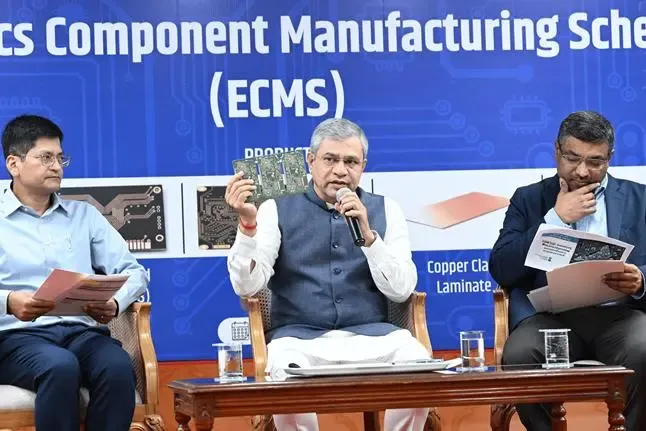Is India’s Electronics Sector Ready for a Major Transformation?

Synopsis
Key Takeaways
- India's electronics sector is set for substantial growth.
- Investment under the ECMS exceeds Rs 5,500 crore.
- Focus on high-value components will strengthen domestic manufacturing.
- Job creation is anticipated to reach 25 lakh.
- Mobile manufacturing has drastically increased over the past decade.
New Delhi, Oct 27 (NationPress) The endorsement of the initial batch of seven initiatives valued at over Rs 5,500 crore under the Electronics Components Manufacturing Scheme (ECMS), revealed by Union Minister Ashwini Vaishnaw on Monday, indicates a robust effort to enhance India’s electronics value chain. This initiative underscores the government’s commitment to establishing a strong domestic foundation for high-value components to facilitate large-scale production, as stated by an official release.
Over the past few years, India’s electronics industry has witnessed remarkable expansion, becoming the third-largest and fastest-growing export sector by 2024–25. The ECMS aims to leverage this growth, steering the country towards its ambition of being a global powerhouse in advanced electronics manufacturing, as highlighted in the statement.
Launched on April 8, the Electronics Component Manufacturing Scheme aims to link India’s electronics sector with international value chains by promoting the local production of essential components, sub-assemblies, and raw materials.
As of September 30, the investment commitments under the scheme have surpassed Rs 1.15 lakh crore, nearly doubling the initial target of Rs 59,350 crore. Production worth Rs 10.35 lakh crore is projected over the next six years, which is 2.2 times the original estimate, according to the statement.
The first approvals encompass a wide array of high-value electronic components and materials essential for modern technology. These projects will bolster India’s role in the global value chain by enabling large-scale production of components utilized in smartphones, automobiles, medical devices, telecommunications, and industrial systems, as explained in the statement.
Camera module sub-assemblies are integral to smartphones, drones, medical devices, and robots. They capture high-resolution images and videos in electronic devices and serve as the imaging core in smartphones, tablets, laptops, security cameras, automotive systems, and IoT devices.
Multi-layer Printed Circuit Boards (PCBs) find applications in automotive, consumer electronics, ICT, medical devices, telecommunications, aerospace and defense, and industrial manufacturing. These PCBs contain multiple copper and dielectric layers interconnected with through-hole vias and are broadly used in consumer electronics, industrial controls, and automotive systems.
High-density interconnect PCBs are utilized in consumer electronics and wearable technology, automotive electronics, medical devices, telecommunications, aerospace, and defense. These are advanced iterations of PCBs featuring microvias, blind and buried vias, via-in-pad structures, finer tracks, and tighter spacing, enabling compact, high-performance designs for smartphones, tablets, wearables, aerospace, and medical devices.
Copper-clad laminates are crucial for automotive, consumer electronics, medical devices, ICT, telecommunications, aerospace and defense, and industrial manufacturing. They serve as the foundational component for the production of multi-layer PCBs.
Polypropylene film is utilized in capacitors across consumer electronics, automotive, ICT, industrial and manufacturing, telecommunications, and computing sectors. It is the primary material employed in capacitor production.
India’s electronics production has escalated from Rs 1.9 lakh crore in 2014–15 to Rs 11.3 lakh crore by 2024–25, signifying a six-fold increase. Exports surged from Rs 38,000 crore to Rs 3.27 lakh crore during the same timeframe, showcasing an eight-fold growth. Over the last decade, electronics manufacturing has generated approximately 25 lakh jobs nationwide.
Mobile manufacturing has been a pivotal aspect of this evolution. Production in this segment has surged from Rs 18,000 crore in 2014–15 to Rs 5.45 lakh crore by 2024–25, marking a 28-fold increase. India now ranks as the world’s second-largest mobile phone manufacturer, with over 300 units operational compared to just two in 2014.
Mobile phone exports have also seen astonishing growth, increasing 127 times from Rs 1,500 crore in 2014–15 to ₹2 lakh crore in 2024–25. In the initial five months of 2025–26, smartphone exports reached Rs 1 lakh crore, reflecting a 55% rise over the same period last year.
India has nearly achieved self-sufficiency in mobile production, transitioning from relying heavily on imports a decade ago to nearly all devices now being manufactured domestically. This transformation highlights the resilience of India’s policy framework and its emergence as a reliable hub for global electronics manufacturing and exports, as noted in the statement.









